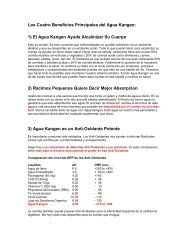ACID-ALKALINE BALANCE: ROLE IN CHRONIC ... - My Kangen Tools
ACID-ALKALINE BALANCE: ROLE IN CHRONIC ... - My Kangen Tools
ACID-ALKALINE BALANCE: ROLE IN CHRONIC ... - My Kangen Tools
Create successful ePaper yourself
Turn your PDF publications into a flip-book with our unique Google optimized e-Paper software.
Y.-R. Huang et al. / Food Control 19 (2008) 329–345 331<br />
Fig. 1. Schematics of electrolyzed water generator and produced compounds.<br />
hydroxide in the diluted salt solution move to the anode to<br />
give up electrons and become oxygen gas, chlorine gas,<br />
hypochlorite ion, hypochlorous acid and hydrochloric acid,<br />
while positively charged ions such as hydrogen and sodium<br />
move to the cathode to take up electrons and become<br />
hydrogen gas and sodium hydroxide (Hsu, 2005). Two<br />
types of water are produced simultaneously. EO water,<br />
with low pH (2.3–2.7), high oxidation–reduction potential<br />
(ORP, >1000 mV), high dissolved oxygen and contains free<br />
chlorine (concentration depends on the EO water machine<br />
setting), is produced from anode side. However, electrolyzed<br />
reduced (ER) water, with high pH (10.0–11.5), high<br />
dissolved hydrogen, and low ORP ( 800 to 900 mV), is<br />
produced from the cathode side. ER water with strong<br />
reducing potential can be used to remove dirt and grease<br />
from items such as cutting boards and other kitchen utensils<br />
(Hsu, 2005).<br />
The principle of producing electrolyzed water is shown<br />
in the Fig. 1 with the following:<br />
Positivepole : 2H 2 O ! 4H þ þ O 2 " þ4e<br />
2NaCl ! Cl 2 " þ2e<br />
þ 2Na þ<br />
Cl 2 þ H 2 O ! HCl þ HOCl<br />
Negativepole : 2H 2 O þ 2e ! 2OH þ H 2 "<br />
2NaCl þ 2OH<br />
! 2NaOH þ Cl<br />
3. Systems for generation of electrolyzed water<br />
Commercial EO water generators can be divided into<br />
three major types based on their automatic control systems.<br />
The first type of EO water generators, made by the<br />
ARV Ò and the Amano Ò companies, allows the users to<br />
select brine flow rate while the machines adjust voltages<br />
and/or amperages automatically. The second type of EO<br />
water generators, made by the Hoshizaki Ò Company,<br />
allows the users to select amperages and/or voltages, while<br />
the machines change brine flow rate accordingly. The third<br />
type of EO water generators, made by the Toyo Ò and the<br />
Nippon Intek Ò companies, allows the users to select a preset<br />
chlorine concentration level of EO water from a display<br />
panel and the machines change brine flow rate and amperages<br />
and/or voltages automatically (Hsu, 2003).<br />
Hsu (2003) investigated relationship among water flow<br />
rate, water temperature and salt concentration on electrolysis<br />
efficiency, and separation efficiency of an EO water<br />
generator. He made following conclusions: (1) electric<br />
potential (7.9–15.7 V) and power consumption (16–<br />
120 W) of electrolysis cell were not affected by water flow<br />
rate, water temperature or salt concentration in the feed<br />
solution; (2) electric current changed with water temperature<br />
and water flow rate; and (3) electrolysis efficiency of<br />
the electrolysis cell and separation efficiency of the ion<br />
exchange membrane were significantly decreased by the<br />
increases in water flow rate and salt concentration in the<br />
feed solution. Later, Hsu (2005) also reported that ORP<br />
decreased with increases in water follow rate and free chlorine<br />
increased with increases of salt concentration and<br />
decrease of water flow rate.<br />
4. The advantages and disadvantages of EO water<br />
The main advantage of EO water is its safety. EO water<br />
which is also a strong acid, is different to hydrochloric acid<br />
or sulfuric acid in that it is not corrosive to skin, mucous<br />
membrane, or organic material. On the other hand, sodium<br />
hypochlorite was proved to have a strong toxicity, such as<br />
skin irritation, membrane irritation, acute toxicity, and so<br />
on (Mori et al., 1997; Sekiya, Ohmori, & Harii, 1997;<br />
Shigeto et al., 2000). Currently used hatchery sanitizers



